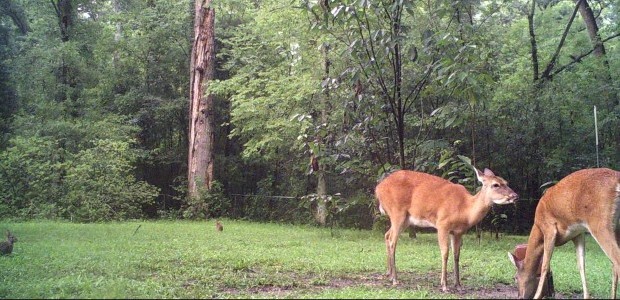DOTD lifts HNC bridge marine curfew; work ongoing
November 6, 2012Post-election results will be realized eventually
November 6, 2012More than 100 cases of hemorrhagic disease – a viral disease syndrome caused by either epizootic hemorrhagic disease virus or bluetongue virus – have been reported in sick or dead deer in southern parishes along the Mississippi River.
“We started getting a few reports of dead or dying deer at the end of July,” said State Wildlife Veterinarian James LaCour with the Louisiana Department of Wildlife and Fisheries. “We get call-ins about cases every year, but not this many. I had two calls today, but the reports peaked a few weeks ago, around the first and second week of October.”
Hemorrhagic disease and bluetongue virus, which are related but genetically different, are spread by biting gnats that thrive in certain weather conditions, mainly a rainy spring followed by a dry June.
“Flooding from the Atchafalaya River and flooding from Hurricane Isaac pushed the deer populations together and helped to spread the disease,” LaCour said. “The disease is mostly seen in the fall, and it will spread until we get our first frost, which will kill the midges. After the frost, the number of new cases will subside, but we will get cases well into the winter.”
Infected deer may exhibit no signs of hemorrhagic disease, simply be found dead or develop symptoms like lethargic movement, swelling of the tongue, head or neck, erosions or ulcers in the mouth, hemorrhages in the eyes and internal organs, hoof-sloughing and weight loss.
“The disease disrupts the lining of the deer’s stomach,” LaCour said. “These deer will eat ravenously but cannot process the nutrients they need. Those deer that are the sickest will die before the winter is over.”
Even though hemorrhagic disease is not contagious to humans and eating meat from hemorrhagic disease-infected animals is not a health risk, hunters are asked to turn in any infected harvested deer or report any dead deer to the nearest LDWF office.
Locally, most of the hemorrhagic disease cases have been in the area where St. James, Assumption and Lafourche parishes converge.
“We have had about 40 reports in that area so far this year,” said LDWF private lands biologist John Henry Harrelson. “Most reports are coming from presidents of hunting clubs. I have been over private lands at the Hammond office for two years and, last year, we didn’t even get any calls.”
John Templet, president of Old Bayou Hunting Club in north Lafourche, has already reported a total of eight or nine hemorrhagic disease cases from the club’s 1,000 and 2,000-acre spots.
“We’ve had a couple here, and the club next door had some, too,” Templet said. “We’ve been doing a lot of work getting ready for hunting season, so we’ve seen a few sick ones and two dead ones.”
The club harvests between six to 14 deer each season, but this year’s harvest may be lower due to the disease.
“About three years ago, I spotted 15 sick deer myself,” Templet said. “That year, we only harvested about eight deer. The disease is nothing new though. I usually hear about a few cases each every year from other area hunters.”
Despite the threat of disease, all other deer signs are giving Templet hope that the season will still be good.
“We just put the cameras out, and the deer in the pictures look healthy,” Templet said. “We have also seen lots of tracks and, with water levels going down, the deer are moving back out into the swamp and to the ridges and levees. The bucks will be on the move in late December when rut comes around.”
Templet said the club will keep its same regulations – LDWF region rules at one spot and one doe and as many bucks as the law allows at the other.
Flooding not the only cause behind outbreak
While Louisiana’s often-erratic weather patterns may partially be to blame for the spread of the disease, LDWF is also exploring another cause behind the number of sick deer – a new strain of hemorrhagic disease.
“LDWF has been researching EHDV 6, a potential new strain of the virus,” LDWF deer program manager Scott Durham said. “Blue tongue and EHDV each have multiple strains, and native deer have no resistance to this new strain according to the Louisiana State University guys at the Idlewild Center. There is not much we can do about it. We just have to let it play out, but healthy, native deer have a pretty good fighting chance of surviving the disease. We have had a very good deer population in Louisiana for several generations.”
“Most of our deer have come or will come in contact with the other strains at some point in their lives,” he added. “It is a prevalent disease, but many survive it. In the parishes where the majority of the calls are coming from, we may see anywhere from a 25 to 50 percent deer mortality rate.”
Durham suggested that hunters refrain from using deer feeders, citing other research that showed saliva to-salvia and nose-to-nose contact between deer may also be spreading the disease. LDWF is also encouraging hunters in the river parishes and areas flooded by Hurricane Isaac to be more conservative and limit their deer harvests this season.
Those resilient deer that survive the new strain will ensure the endurance of future generations of deer by passing the genetic trait and developed antibodies that helped them survive the disease, but pen-raised and imported may not be as lucky.
“The disease is hitting some of these exotic deer pretty hard,” he said. “They also do not have a resistance to the disease, but our deer are much stronger.”
“There have been hemorrhagic disease outbreaks all over the country this year, even up north,” he said. “It’s a big year for hemorrhagic disease all over the place.”
Louisiana deer hunters may see sick or dead deer into late winter. More than 40 hemorrhagic disease cases were reported in the area where St. James, Assumption and Lafourche parishes converge.










